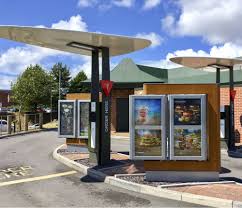In an age where convenience reigns supreme, drive thru systems have become a vital component in the service landscape of fast-food restaurants, banks, pharmacies, coffee shops, and even COVID-19 testing centers. Saudi Arabia, a country on a rapid path toward digital transformation under Vision 2030, is embracing drive thru systems not just as a Western trend but as a strategic move to improve customer satisfaction, reduce wait times, and boost business efficiency.
In this blog post, we’ll explore the mechanics, benefits, challenges, and future of drive thru systems—with a special focus on the drive thru system in Saudi Arabia. Whether you’re a business owner looking to implement one or a curious reader observing Saudi Arabia’s rapid tech adaptation, this article is for you.
🚦 What Is a Drive Thru System?
A drive thru system is a service model where customers receive goods or services without leaving their vehicles. Originally popularized in the fast-food industry, drive thru systems now extend to:
- Pharmacies
- Banks
- Grocery pickups
- COVID-19 testing
- Coffee shops
- Government services (in some countries)
Drive thru systems aim to reduce waiting time, ensure contactless delivery, and enhance customer convenience—all critical elements in a fast-paced world.
📚 History and Evolution of Drive Thrus
The concept of the drive thru originated in the United States in the 1930s, evolving from drive-in theaters and diners. Over time, it became a standard in fast-food chains like McDonald’s, Burger King, and KFC.
From rudimentary speaker systems to mobile apps and AI-integrated kiosks, drive thrus have come a long way.
🔄 Drive Thru Technology: Then vs. Now
| Feature | Old Drive Thru System | Modern Drive Thru System |
|---|---|---|
| Ordering Method | Intercom speaker | Digital touchscreen or app |
| Queue Management | Manual | Automated number/ticketing system |
| Payment | Cash only | Digital wallets, NFC, QR codes |
| Communication | Basic speaker & mic | HD cameras, AI voice assistants |
| Analytics | None | Real-time reporting & feedback |
⏱️ Why Drive Thru Systems Matter in 2025
Drive thru systems have gone from luxury to necessity. In a post-COVID world, customers want:
- Contactless service
- Speedy transactions
- Reduced crowding
- Digital payment and ordering
In Saudi Arabia, these preferences align well with Vision 2030, which encourages the modernization of services and customer experience.
✅ Benefits of Drive Thru Systems
- Time-saving
- Hygienic and safe
- Convenient for differently-abled or elderly customers
- Reduced overhead costs for businesses
- Increased order volume capacity
Drive thru systems also allow for customer satisfaction through efficient queue management and multilingual interfaces, essential in countries like Saudi Arabia with diverse populations.
❌ Challenges of Traditional Queues
Before the advent of drive thrus, customers faced:
- Long wait times
- Close contact in queues (problematic post-pandemic)
- Higher customer drop-off rates
- Increased staff workload
These limitations encouraged businesses to explore modern alternatives, such as drive thru systems equipped with queue optimization software.
🇸🇦 Drive Thru System in Saudi Arabia
The drive thru system in Saudi Arabia is rapidly evolving. What started with international food chains is now a booming sector for:
- Local cafés (e.g., Barn’s)
- Pharmacies (e.g., Tadawi)
- Banks (e.g., Al Rajhi)
- Government services (e.g., Absher kiosks)
- Testing and vaccination centers
Key reasons for drive thru adoption in Saudi Arabia:
- High car ownership rate
- Hot climate discouraging walk-ins
- Vision 2030 focus on digital transformation
- COVID-19 impact accelerating contactless services
🏢 Sectors Using Drive Thru Systems in KSA
🥤 1. Fast Food Chains
McDonald’s, Herfy, Al Baik, and Kudu offer seamless drive thru ordering, many integrated with apps like HungerStation or Jahez.
🏦 2. Banks
Al Rajhi and other banks now allow drive-thru ATMs and service windows for quick transactions, including cash deposits and document submissions.
💊 3. Pharmacies
Drive thru pharmacies are gaining popularity post-pandemic, where you can:
- Refill prescriptions
- Pick up medication
- Consult pharmacists from your car
🧪 4. Healthcare
From COVID-19 testing to flu shot drives, Saudi hospitals and clinics utilize temporary or permanent drive thru setups.
☕ 5. Coffee Shops
Local chains like Barn’s and international ones like Starbucks have embraced drive thru kiosks, enhancing customer flow during peak hours.
📈 Case Studies of Successful Implementation in KSA
Case 1: Starbucks Drive Thru in Riyadh
By integrating app ordering with drive thru pickup, Starbucks reduced wait times by 40% during peak hours.
Case 2: Al Rajhi Bank Drive Thru
The bank introduced paperless document verification at drive thru kiosks, increasing transaction efficiency by 60%.
Case 3: Tadawi Pharmacy
Introduced drive thru prescriptions in Jeddah, allowing the elderly and sick to safely receive medication without getting out of their vehicles.
🛠️ How to Set Up a Drive Thru System
1. Site Selection
Choose a location with sufficient space for vehicle lanes and easy entry/exit points.
2. Queue Management Integration
Use software or token systems to reduce vehicle backlog.
3. Communication Technology
Install HD speaker systems, cameras, or AI-powered kiosks.
4. POS Systems
Enable card payments, NFC, and QR code scanning.
5. Staff Training
Train staff for speed, accuracy, and politeness—key aspects of customer satisfaction.
🤖 The Future of Drive Thrus: AI, IoT, and Beyond
Drive thru systems are evolving with the help of:
- AI-powered voice ordering systems
- License plate recognition for loyalty rewards
- IoT for equipment monitoring and maintenance
- Data analytics for queue prediction
These technologies are already being tested in Saudi Arabia’s major urban centers.
🌍 Environmental Impact of Drive Thrus
While convenient, drive thru systems can increase vehicle idling, contributing to emissions. Solutions include:
- Idle-reduction policies
- Hybrid or EV-only lanes
- Smart scheduling for reduced congestion
Saudi Arabia’s green initiative aligns with these solutions to reduce carbon footprint.
👥 Customer Behavior and Expectations
Modern customers expect:
- Short wait times
- Polite staff
- Flexible payment methods
- Accurate and fresh service
- Eco-friendly practices
Drive thru systems must align with these expectations to ensure customer loyalty.
🧠 Final Thoughts and Industry Outlook
Drive thru systems are no longer a novelty—they are a necessity. In Saudi Arabia, where lifestyle, climate, and innovation converge, the growth of drive thru systems is unstoppable. From local coffee shops to high-end banking services, businesses that prioritize drive thru convenience will be the ones leading the future.
As more sectors adopt drive thru solutions, supported by AI and data-driven platforms, we can expect personalized customer experiences, zero-contact operations, and sustainability-driven enhancements—all signs of a progressive, customer-centric Saudi Arabia.
❓FAQs
1. What is a drive thru system?
A drive thru system is a method of delivering goods or services to customers in their vehicles, reducing the need to enter the premises.
2. Which sectors use drive thru systems in Saudi Arabia?
Fast food, banking, pharmacies, coffee shops, and healthcare sectors are leading the adoption of drive thru systems.
3. How has COVID-19 affected drive thru systems in Saudi Arabia?
COVID-19 accelerated the demand for contactless services, making drive thrus a preferred choice for safety and convenience.
4. What technologies are used in modern drive thrus?
Technologies include AI-powered kiosks, mobile ordering apps, digital payment systems, and queue management tools.
5. Are drive thru systems environmentally sustainable?
While they can contribute to emissions due to idling, solutions like EV lanes and smart traffic flow can mitigate the environmental impact.



